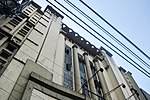Quiapo, Manila
Commons link is defined as the pagenameDistricts of ManilaQuiapo, ManilaUse Philippine English from November 2022Use mdy dates from November 2022

Quiapo ([ˈkjapɔʔ]) is a district of the city of Manila, in the National Capital Region of the Philippines. Referred to as the "Old Downtown of Manila", Quiapo is home to the Quiapo Church, where the Feast of the Black Nazarene is held with millions of people participating annually. Quiapo has also made a name for itself as a place for marketplace bargain hunting. Quiapo is geographically located at the very center of the city of Manila. It is bounded by the Pasig River and Estero de San Miguel to the south, San Miguel to the east, Recto Avenue to the north and Rizal Avenue to the west.
Excerpt from the Wikipedia article Quiapo, Manila (License: CC BY-SA 3.0, Authors, Images).Quiapo, Manila
Ronquillo Street, Manila Quiapo (Third District)
Geographical coordinates (GPS) Address Nearby Places Show on map
Geographical coordinates (GPS)
| Latitude | Longitude |
|---|---|
| N 14.6 ° | E 120.983 ° |
Address
Alzate Building
Ronquillo Street 680-690 (even)
1001 Manila, Quiapo (Third District)
Philippines
Open on Google Maps







